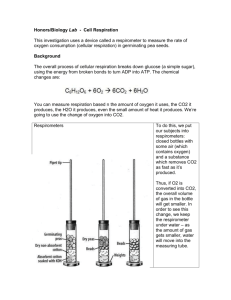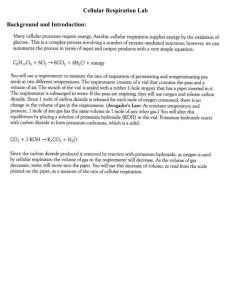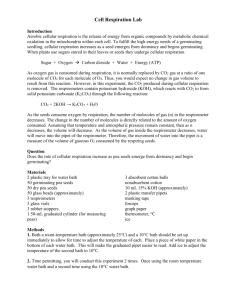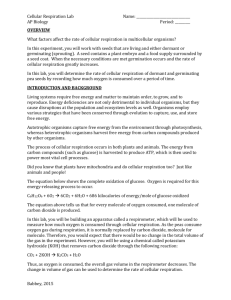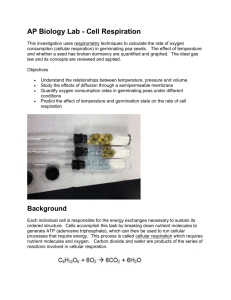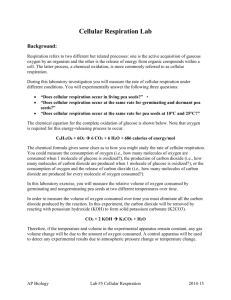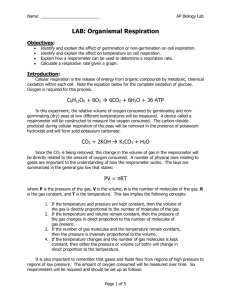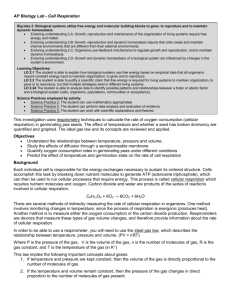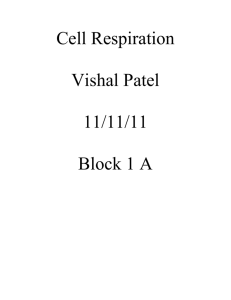Investigation 6: Cellular Respiration Lab
advertisement
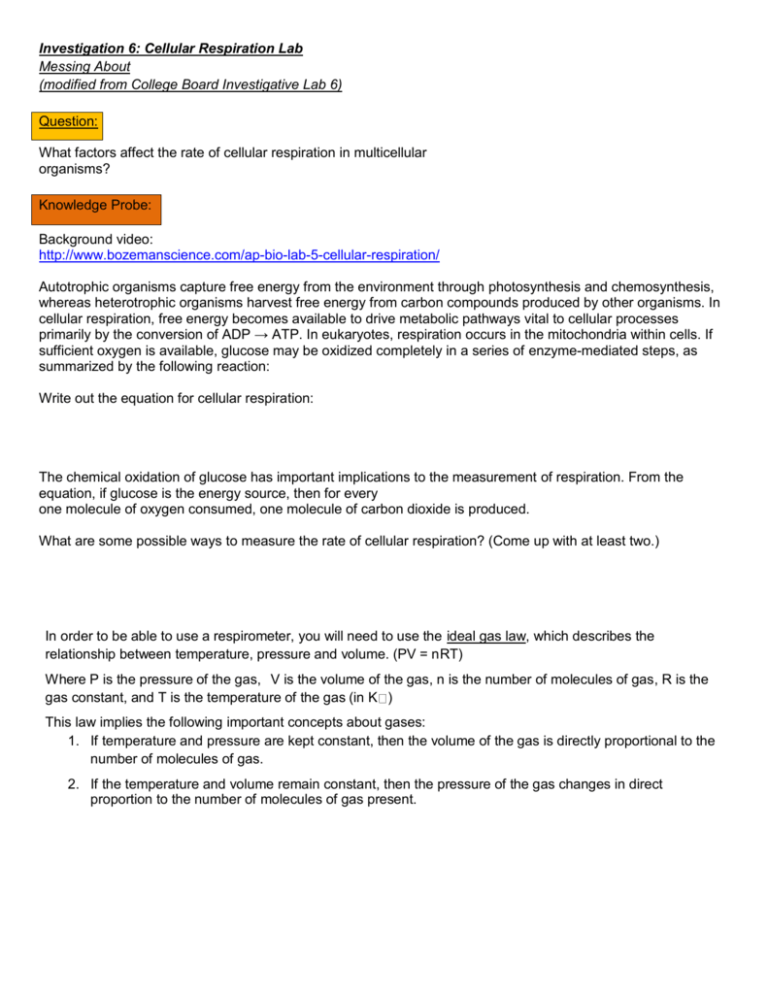
Investigation 6: Cellular Respiration Lab Messing About (modified from College Board Investigative Lab 6) Question: What factors affect the rate of cellular respiration in multicellular organisms? Knowledge Probe: Background video: http://www.bozemanscience.com/ap-bio-lab-5-cellular-respiration/ Autotrophic organisms capture free energy from the environment through photosynthesis and chemosynthesis, whereas heterotrophic organisms harvest free energy from carbon compounds produced by other organisms. In cellular respiration, free energy becomes available to drive metabolic pathways vital to cellular processes primarily by the conversion of ADP → ATP. In eukaryotes, respiration occurs in the mitochondria within cells. If sufficient oxygen is available, glucose may be oxidized completely in a series of enzyme-mediated steps, as summarized by the following reaction: Write out the equation for cellular respiration: The chemical oxidation of glucose has important implications to the measurement of respiration. From the equation, if glucose is the energy source, then for every one molecule of oxygen consumed, one molecule of carbon dioxide is produced. What are some possible ways to measure the rate of cellular respiration? (Come up with at least two.) In order to be able to use a respirometer, you will need to use the ideal gas law, which describes the relationship between temperature, pressure and volume. (PV = nRT) Where P is the pressure of the gas, V is the volume of the gas, n is the number of molecules of gas, R is the gas constant, and T is the temperature of the gas (in K ) This law implies the following important concepts about gases: 1. If temperature and pressure are kept constant, then the volume of the gas is directly proportional to the number of molecules of gas. 2. If the temperature and volume remain constant, then the pressure of the gas changes in direct proportion to the number of molecules of gas present. 3. If the number of gas molecules and the temperature remain constant, then the pressure is inversely proportional to the volume. 4. If the temperature changes and the number of gas molecules are kept constant, then either pressure or volume (or both) will change in direct proportion to the temperature. 5. It is also important to remember that gases and fluids flow from regions of high pressure to regions of low pressure. During cellular respiration, two gases are changing in volume. Oxygen gas is being consumed by the respiring cells and carbon dioxide gas is diffusing out of the cells. The respirometer, therefore, has to be able to deal with two simultaneously changing gas volumes. This is accomplished by introducing potassium hydroxide into the device. KOH absorbs carbon dioxide, following this equation: CO2 + + 2KOH → K2CO3 + H2O Potassium carbonate (K2CO3) is a solid precipitate. Any CO 2 produced is immediately converted from a gas to a solid and is therefore no longer governed by gas laws. Since the carbon dioxide is being removed, the change in the volume of gas in the respirometer will be directly related to the amount of oxygen consumed. In the experimental apparatus if water temperature and volume remain constant, the water will move toward the region of lower pressure. During respiration, oxygen will be consumed. Its volume will be reduced, because the carbon dioxide produced is being converted to a solid. The net result is a decrease in gas volume within the tube, and a related decrease in pressure in the tube. The vial with glass beads alone will permit detection of any changes in volume due to atmospheric pressure changes or temperature changes. The amount of oxygen consumed will be measured over a period of time. Two sets of three respirometers will be assembled during this lab exercise. Each set will be incubated at a different temperature. One respirometer will contain germinated seeds, one will contain a mix of nongerminating seeds and glass beads, and a third will contain only glass beads. The purpose of the beads is to ensure that each respirometer is uniform in volume. The vial with glass beads alone will permit detection of any changes in volume due to atmospheric pressure changes or temperature changes. The respirometers will also contain a layer of cotton that has been saturated with KOH so that carbon dioxide will be absorbed. The respirometers will be submerged in a pan of water; water will flow from an area of high pressure to an area of low pressure. As oxygen is used up by the respiring seeds, the gas pressure inside the respirometer will decrease and the water will flow into the pipet down its pressure gradient. Prediction: Write a prediction – Is it connected to prior knowledge? Is the prediction an expected outcome? →Investigative Plan: If you need to a visual on the process, please refer to Lab Bench: Cellular Respiration. Lab Materials: 50 germinating pea seeds, 50 dry seeds, 100 plastic beads, 3 respirometer vials, Weights for vials, 3 stoppers, 1 ml graduated pipets, sealant (Vaseline), absorbent cotton, nonabsorbent cotton, 1 round wood stick, 3 pieces of paper towel, marking pen, water bath, ice, 100 ml graduated cylinder, thermometer, masking tape, stopwatch or clock, water. Dropper Bottle of 15% KOH The amount of O2 consumed will be measured over a time course. The experiment requires six respirometers Respirometer 1 2 3 Temperature Room Room Room Contents Germinating Seeds Dry Seeds + Beads Beads Safety – wear safety goggles. KOH is caustic, avoid direct skin contact. If contact occurs, flush affected area with running water for 10 minutes. Procedure: Day 1 (Setting up respirometers) 1. Set up a room-temperature bath (approximately 25°C). 2. Respirometer 1: Obtain a 100-mL graduated cylinder and fill it with 50 mL of water. Place 25 germinating peas into the graduated cylinder. Measure the amount of water that was displaced (which is equivalent to the volume of the peas) and record this number. PEA VOLUME = mL This number is the volume of the peas, and will be used to determine the volume of peas and beads in the other respirometers (all volumes should be equal). Remove the peas and place them on a paper towel. These peas will be used in Respirometer 1. 3. Respirometer 2: Refill the graduated cylinder until it has 50 mL of water. Place 25 dried peas (they are dormant, and not germinating) into the graduated cylinder and then add enough glass beads to reach a volume equivalent to that of the germinating peas in Respirometer One. Remove the peas and beads and place them on a paper towel. These peas and beads will be used in Respirometer 2. 4. Respirometer 3: Refill the graduated cylinder until it has 50 mL of water. Fill it with glass beads alone until the volume is equivalent to the volume of the germinating peas in Respirometer 1. Remove these beads and place them on a paper towel. These beads will be used in Respirometer 3. 7. To assemble the respirometers, obtain 3 vials, each with an attached stopper and pipette. Make sure that the vials are dry on the inside. It is important that the amounts of cotton and KOH be the same for each respirometer. Place a small wad of absorbent cotton in the bottom of each vial and, using a dropper, saturate the cotton with 15% KOH. Do not get KOH on the sides of the respirometer. Place a small wad of dry nonabsorbent cotton on top of the KOH-soaked absorbent cotton. 8. Place the first set of germinating peas, dry peas + beads, and beads in vials one, two, and three, respectively. 9. Place the second set of germinating peas, dry peas + beads, and beads in vials four, five, and six, respectively. 10. Insert the nontapered end of one pipet into the upper surface of one of the rubber stoppers. It should fit tightly. Place a layer of sealant around the junction between the pipet and the stopper so that no air can escape. (*The pointy end of the pipet should be outside, not inside) Procedure: Day 1 (Setting up system) 1. Place a strip of masking tape across the narrow width of the water bath, approximately 2/3 of the way from one end (see diagram). 2. Place respirometers 1, 2, and 3 into the room temperature water bath. Add a drop of red food coloring in the tip of the pipet. 3. At the end of 7 minutes, submerge each of the tubes entirely in the water bath. Some water will enter the tip of the pipet, but the influx of water should stop fairly quickly. If it does not stop, check the respirometer for leaks. 4. At this point, check to make sure you can read the pipets. The air bubble should extend from the main chamber up the tube of the pipet. The pipet may need to be rotated so that you can see the numbers. If your respirometers float, you may need to weight them. 5. Record the water level in each pipet onto the data table at the Time Interval 0. 6. Record the position of the water in each pipet at the end of 5, 10, and 15, 20 min on Data Table 2. Observations: Table1: Calculation of Volume in Respirometers Initial Volume (mL) Final Volume (mL) Volume of beads/seeds Respirometer (germinating seeds) Respirometer (non germinating) 50 50 Respirometer (beads only) 50 Table 2. Measurement of O2 Consumption by Germinating and NonGerminating Seeds at Room Temperature Temp (C) Room Time (min) Beads Alone Reading at Time X Diff.* Germinating Seeds Reading at Time X Diff.* Corrected diff. ∆ Nongerminating Seeds and Beads Reading Corrected Diff.* at Time X diff. ∆ 0 5 10 15 20 *Difference = (initial reading at time 0) – (reading at time X) △Corrected Difference = (initial seed reading at time 0 – seed reading at time X) - (initial bead reading at time 0 – bead reading at time X) Record data on class data sheet and then record in your lab book. Data Analysis: 1. 2. 3. 4. Identify and interpret observations. Determine what data are significant. Identify patterns and trends that will help explain the data. Choose data analysis strategy (statistics, graphing…) Investigation 6: Cellular Respiration—Day 2 Inquiry (modified from College Board Investigative Lab 6) To get you thinking on your class question: • What environmental variables might affect the net rate of cellular respiration? Why do you think they would affect it? How do you predict they would affect it? • Do different organisms respire at a different rate? How do you know? • Does it matter how many days a plant has been germinating? Does that impact that rate of respiration? Question: Knowledge Probe: What do you need to know in order to write a prediction? Hypothesis: Write a prediction – Is it connected to prior knowledge? Is the prediction an expected outcome? →Investigative Plan: Make sure that your investigative plan is: 1. Numbered, logical and concise. 2. Clear enough to enable another person to repeat the investigation 3. May include drawings. 4. Description of what data to gather and how much. 5. What materials are necessary. 6. Number of trials to conduct. 7. How to minimize error. Observations: 1. Are qualitative and quantitative observations listed and labeled? 2. Are opinions and prior knowledge excluded? 3. Are the date recorded in an organized way? Data Analysis: 1. 2. 3. 4. Identify and interpret observations. Determine what data are significant. Identify patterns and trends that will help explain the data. Choose data analysis strategy (statistics, graphing…) Explanation: • Claim: Answer your investigation question. State concisely what your evidence suggests. • Evidence: Use your evidence to support the claim. • Reasoning: Justify why the evidence supports the claim. • • • • How does the data support or challenge your personal knowledge? How was your investigation a fair test? How confident are you? How can you use currently accepted scientific knowledge? How can you use ideas, evidence, or arguments of others? Evaluation: a. b. c. d. e. f. What are the sources or error? What should you do differently next time? How confident are you in your results? Was there anything surprising? What would your prediction be if you conducted this investigation again? What question would you like to pursue next? Application: • • Extend what you have learned in our investigation to other situations (outside the classroom). Think about the big concepts we are learning (osmosis and water potential), AND think about our learning process in general (ex. Why is accuracy or communication… important not only in labs but in other fields) Reflect on how you demonstrated critical thinking (important in science) or lack of self direction in this lab? Self-Direction = Actively, persistently, and carefully considering beliefs, information, or knowledge in light of new evidence. Critical thinking entails questioning, analyzing, interpreting, synthesizing, reasoning, evaluating, and selfreflection.
